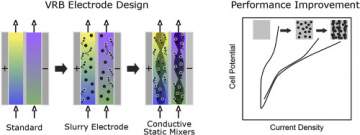Abstract: A key objective in the development of vanadium redox flow batteries (VRFBs) is the improvement of cell power density. At present, most commercially available VRFBs use graphite felt electrodes under relatively low compression. This results in a large cell ohmic resistance and limits the maximum power density. To date, the best performing VRFBs have used carbon paper electrodes, with high active area compression pressures, similar to that used in fuel cells. This article investigates the use of felt electrodes at similar compression pressures. Single cells are assembled using compression pressures of 0.2–7.5 bar and tested in a VRFB system.
The highest cell compression pressure, combined with a thin Nafion membrane, achieved a peak power density of 669mWcm?2 at
a flow rate of 3.2 mL min?1 per cm2 of active area, more than double the previous best performance from a felt-VRFB. The results suggest that felt electrodes can compete with paper electrodes in terms of performance when under similar compression pressures, which should help guide electrode development and cell optimization in this important energy storage technology.
Keywords: vanadium redox flow battery; graphite felt; flow battery power density; cell ohmic resistance; electrode compression

